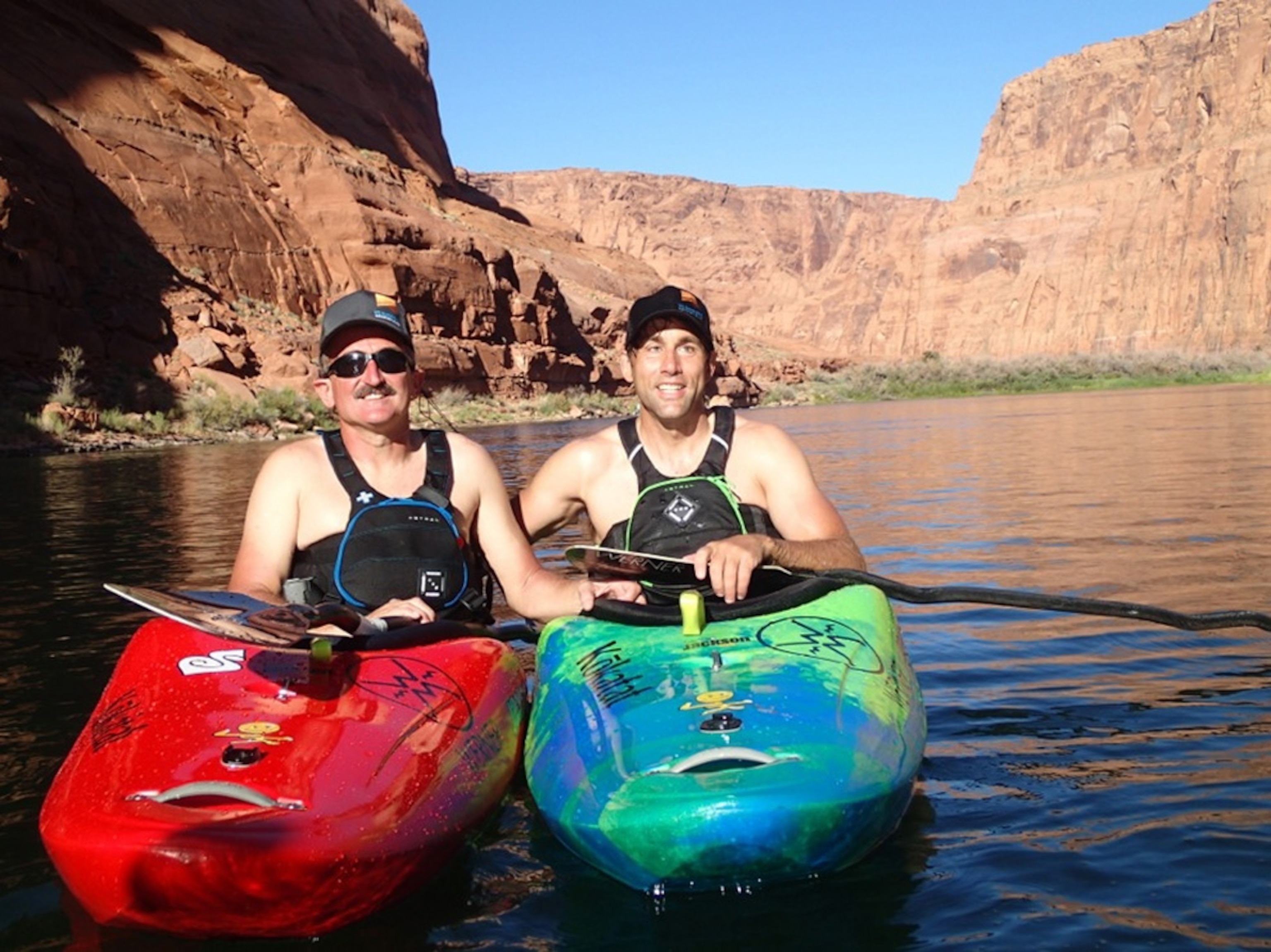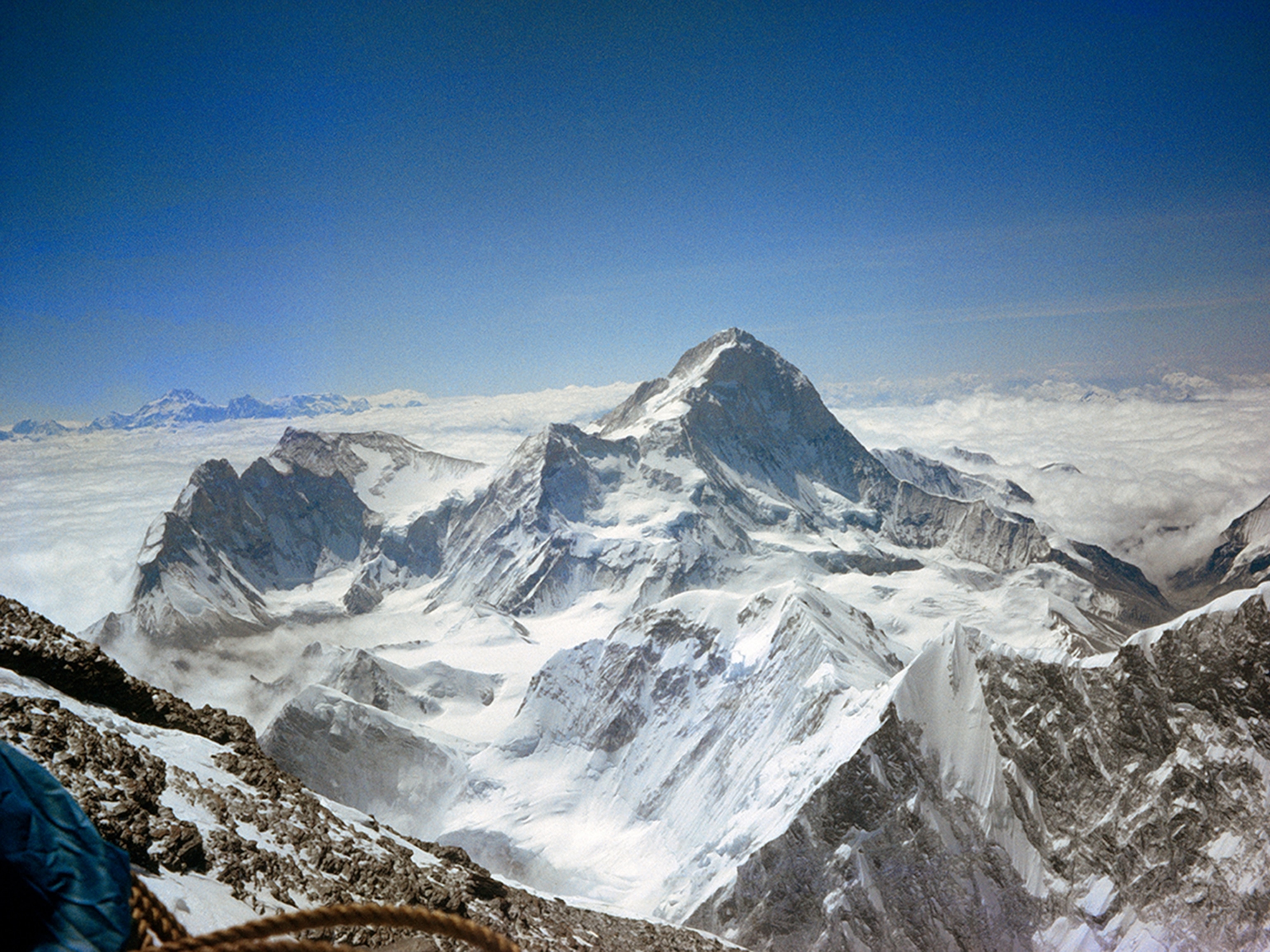
Blind Adventurers Erik Weihenmayer and Lonnie Bedwell
Two kayakers descend the Grand Canyon to break barriers.
When Erik Weihenmayer decided he wanted to kayak the Colorado River in Arizona’s Grand Canyon, he ran the stretch of river in a motorboat to make sure the goal seemed feasible, then spent six years meticulously developing his skills as a paddler. When Lonnie Bedwell decided he wanted to paddle the Colorado River, he hauled a borrowed kayak across his pasture to his pond, where he practiced his roll 1,500 times. When he got in his kayak at Lee’s Ferry to paddle more than 200 miles of the biggest water in the United States, he had a total of 14 days of white-water experience.
“It's absolutely the embodiment of adventure kayaking,” says Timmy O’Neill, a kayaker, climber, and adaptive sports mentor with Paradox Sports. O'Neill has run the river 14 times and served as backup and support should something go wrong. “The river is immense, and it's so remote. You're not just a couple of hours from the takeout; you could be a couple of weeks away.”
Adventure kayaking doesn’t necessarily mean highly technical kayaking. The biggest rapids on the Colorado don’t exceed Class IV white water—not outrageous for an experienced paddler. It's a river people kayak all the time. But Weihenmayer and Bedwell are both blind.
Weihenmayer, 46, best known as the first blind person to climb Everest and all of the other Seven Summits, lost his vision at age 13 to a disease called juvenile retinoschisis. Bedwell, 49, lost his sight in a hunting accident at age 31, three years to the day after the Navy released him from active duty. Neither of them knew how to kayak before they lost their vision—or before they began preparing to paddle the Grand Canyon.
“I felt like I was getting worked in a washing machine in agitation mode on steroids,” says Bedwell, who lives in Dugger, Indiana, population 908 and not exactly a hotbed for kayaking.
The trip lasted 21 days, between September 7 and 27, and covered 277 miles. The first two and a half weeks went remarkably smoothly. Bedwell navigated the rapids by following a guide in front of him who yelled instructions upstream. Weihenmayer’s two guides followed him, giving him directions via waterproof Bluetooth radios. Both men flipped and rolled back up countless times, but neither swam out of his boat—until day 15, when they hit the most infamous rapid in the Grand Canyon: Lava Falls. As Weihenmayer paddled in, the massive rapid grabbed his boat and flipped it, sending him over the falls upside down, head underwater. He released his kayak skirt and swam to the bottom to avoid getting smashed into a rock, sucked into a hole or trapped by his overturned boat.
The next day, unwilling to accept defeat, Weihenmayer hiked back around to the top of the offending rapid.
“Part of me wanted to just say, ‘No way! Why would I ever go back to that and do that thing again?’” Weihenmayer admits. “I just felt like I had to. Three rolls later, I was upright in my boat at the bottom of the rapid. There was a lot of hugging and crying. Mostly from me,” he laughs.
Weihenmayer and Bedwell originally decided to attempt to paddle the river completely independent of one another. Bedwell had actually kayaked 225 miles of the Grand Canyon in August 2013. Weihenmayer convinced him to run the river again in September 2014.
Bedwell gladly agreed. Despite their differences in approach and background, the two men have one thing decidedly in common—they both want to use their adventures to inspire others to transcend their own barriers.
“When one guy who's blind goes down and kayaks the Grand Canyon, it's easy to write him off as an anomaly: ‘That guy's just crazy.’ But two blind guys doing it, [and] it becomes more of a story about what's possible for a lot of people,” Weihenmayer reasoned. “I could care less whether people climb mountains or kayak, but we're hoping that people look within themselves and say, What am I capable of doing?”
—Jen Altschul
THE INTERVIEW
National Geographic Adventure: Erik, How would you describe Lonnie?
Erik Weihenmayer: We call him “Lonnie the Lawn Dart” because he's just so gung ho! I'm the opposite of that. I'm supercautious. I'm all about picking the perfect line and trying to be precise about it. Lonnie's just like, “Send me into the biggest hole, that looks fun!"
NGA: Lonnie, how would you describe Erik?
Lonnie Bedwell: We fed off each other. Erik is such a good person and a wonderful man. And to be a part of that, and to do it with him—I don't know how to put it in words. What a privilege.
NGA: How did running the Grand Canyon the second time compare to the first time?
LB: This time I had more experience, I was more competent, so I pushed myself in ways that I didn't last year. I ran some of the rapids backward. I ran some of them completely solo, without a guide—they just lined me up and I would just go and feel my way through. That was such a feeling of freedom and independence, a feeling I had lost when I lost my eyesight. And that was a wonderful feeling, to know that it's just me and the kayak and the paddle, feeling the water and hearing the sounds and trying to think, That's the line, there it is. Quite frankly, it brought tears to my eyes.
- National Geographic Expeditions
NGA: Did you do any of the outdoor activities you do now before you lost your vision?
EW: I had this rare eye disease called retinoschisis. It was unraveling my retinas, so if I got any kind of bang on the head, my retinas would detach more quickly. So I wasn't allowed to do any contact sports. I loved running through the woods and jumping off of rocks and trees into piles of leaves—and borrowing my friend's mini-bike and flying around the neighborhood. I had a little bit of a crazy streak back then. Maybe call it an adventurous streak. I just didn't know if I could be an athlete or not because I wasn't able to do much. So when I finally went totally blind it didn't matter anymore. The gloves were off, and I could do anything I wanted. So going blind made me an athlete. That's the weird part.
LB: Kayaking? No. Rope climbing or vertical climbing? No. Snow skiing? No. I went skiing one day when I had my eyesight, and I thought, Okay, I can do this, I'll just go to the top of the mountain. I started down, I wiped out and yard-saled all my stuff, and I spent the rest of the time I had trying to find it all. So I [had] literally made a 200-yard descent on snow skis, and that was it. And that was back in 1980. So, no, I didn't.
NGA: How does kayaking blind compare to the other activities you've done?
EW: Kayaking is way more involved. Climbing is slow and methodical and about endurance and power. I've always felt comfortable in that realm. Kayaking, you get thrown into absolute chaos. It's like, in the next two minutes, you have to make dozens of decisions that are either going to get you through the rapid or get you hammered. It's all about responding beyond thinking, just execution, and responding to that chaos. In a way, [it's about] just being loose and in the moment. It's way more intense than even climbing.
NGA: What’s next?
LB: I don't know; what do you want to do next? I don't have a bucket list. What do you want to do next? You can see it, let's do it.







